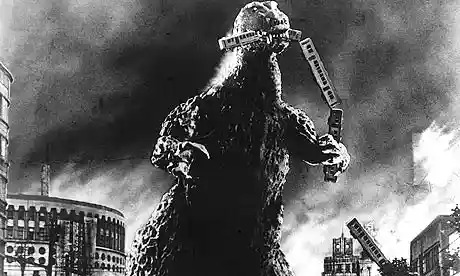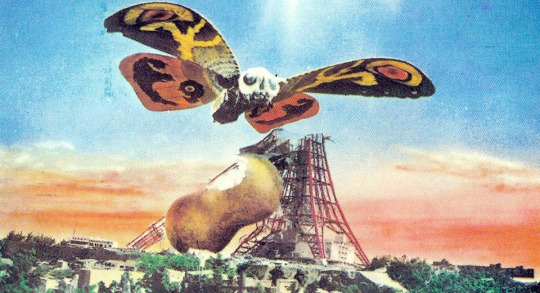#i never thought i'd ever actually use that tag in a godzilla post
Explore tagged Tumblr posts
Text
The pulp origins of Godzilla
I am incredibly pleased to announce that, amidst my quest to find pulp characters across the world and the history of pulp across changing nations and time periods and audiences, I discovered that one of the biggest icons had actually been one of my favorite characters of all time ever and in plain sight all along: Godzilla.
Yup, you heard me right, Godzilla is a pulp character. And no, this isn’t me stretching the barely-existent definition of pulp hero to encompass a character I like and want to talk about, as I usually do. No, this time I stumbled onto a piece of information that lets me make this claim with veracity.
Meet the first version of Godzilla ever created: The Godzilla of the 1954 pulp novel Gojira, by Shigeru Kayama, one of Japan’s most prominent pulp writers at the time. Published about a month before the film, and the first version of Godzilla ever officially released to the public.

The following excerpts are taken from the Project Kayama website, where you can find the novel available for reading
In the 1950s, Kayama was one of Japan’s preeminent science-fiction authors.
In 1952, Kayama published a particularly bizarre and horrific tale: a story in which a large, lizard-like monster that stands upright on two legs wrecks terrifying havoc on the residents of a pacific island. The story’s name was Jira Monster, and both its name and plot foreshadowed the cinematic beast that was to come.
It was his talents that Toho producer Tomoyuki Tanaka sought out after deciding to pursue the creation of a giant monster film.
A mere 11 days after accepting the assignment, Kayama had completed his 50-page outline. The manuscript – stamped as CONFIDENTIAL and titled G-Sakuhin Kentoyo Daihan (G-Production Script for Examination) was submitted to Toho before the end of May.
As many G-fans know, much was changed from Kayama’s original concept. By the time Godzilla went before cameras, the monster itself had evolved from a vague, reptilian beast with flappy ears and a hunger for cattle into an allegorical destroyer whose lack of clear motivation was its greatest terrifying strength. Dr. Yamane, originally conceived as a mysterious, cloak-wearing weirdo living in a gothic mansion, had transformed into the distinguished and kindly Takashi Shimura.
Despite the changes that Ishiro Honda and writer Takeo Murata would make to the tale, the basic structure and flow of the plot remained the same. It was Kayama who envisioned Japanese fishing ships sinking amidst radioactive fire, an island where a giant beast-god is worshipped by fearful villagers, the deadly fire that spews forth from Godzilla’s mighty maw, and a terrifying new super weapon whose use against the monster leads to the heroic suicide of a war-scarred scientist.
Upon its release, Godzilla became a smash hit. But a little over a week before Japanese audiences got their first cinematic look at the monster, the story was already available to the public in the form of a full novelization.
First published via Iwatani on October 25, 1954, Kaiju Gojira (Monster Godzilla) was penned by Shigeru Kayama, but retained little of his original vision for the story. This adaptation of the original Godzilla drew from two different sources: Honda and Murata’s initial script for the film, and Toshi Tatsuno’s serialized radio-drama adaptation of the same script.
August Ragone, writer of EIJI TSUBURAYA: MASTER OF MONSTERS, additionally writes
Actually, there is literally tons of concrete evidence of the Japanese equivalent of American pulps. These have been chronicled in books on the history of Bokura magazine (and other such nostalgic retrospectives), as well as books on the Post War period and children's toys and hobbies of the Post War (1950-1970).
As soon as the war ended, a number of Japanese editions of American publications, such as Amazing Stories began to flood the market -- as well as Japanese-penned stories (Japanese children were especially fascinated by tales of the American Wild West, Science Fiction and Jungle Adventures)
During and after the war, there were numerous cheaply-printed, garish periodicals aimed at children -- not to be confused with manga (comic books), which contained exciting illustrated stories. These continued into the 1960s, but slowly absorbed as features of larger weekly or monthly manga anthologies, mostly containing serialized comics (the size of phone books), and were largely phased out by the 1980s.
In fact let’s look at the whole process behind Godzilla’s debut on pop culture again: Started off with an idea, that then became a novel, partially based on a radio drama, and then made a big hit as a film. That is exactly the kind of trajectory most of the pulp heroes took when getting adaptations outside of their original material. It’s the same trajectory that The Shadow followed, from book to radio to film. Vastly different circumstances that led to them getting there, sure, and Godzilla’s obviously grown into something much more vast and influential than his origins, like other pulp-influenced properties that broke big into the mainstream, but the fact remains that Godzilla began life, first made his debut in pop culture, as a pulp character, by the most exact definition possible.

Not that I actually ever needed an excuse to talk about Godzilla, my other favorite character of all time, and of course I have a “Shadow meets Godzilla” post on the pipeline because of this, but this really was a revelation that threw a lot of things into context for me.
Actually, not just Godzilla. Turns out, my other other favorite character of all time, Mothra, also had a start in magazines. As a serialized novel written in 1961 called The Luminous Fairies and Mothra, that eventually got adapted and turned into a feature film. Which only makes sense especially considering Mothra has an incredibly similar story to King Kong, which is commonly put side by side with pulp characters, and the kaiju’s connection to Kong has reemerged time and time again.

And you can bet I have a lot of further things to say about this, but that’s for a different post. I’m just sitting here unreasonably happy that I finally found a reason to put The Shadow and Godzilla in the same room (not that I needed one).
#kaiju tag#pulp heroes#pulp fiction#i never thought i'd ever actually use that tag in a godzilla post#godzilla#mothra
21 notes
·
View notes